As a kid, you probably had your favorite dinosaurs, and if you care to admit it, you still do today. Maybe your favorite is even a carnivore like the t-rex or velociraptor (we see you, Chris Pratt). They’re awesome in the movies, but thinking about what they were like in real life, we can agree we’re pretty glad they’re extinct today. (Unless a few could be safely kept in a zoo on an island somewhere . . . what could go wrong?) Carnivorous dinosaurs are definitely the stuff of nightmares. It’s impossible to determine which is most terrible, so in no particular order, we’ve created for you a field guide to hungry meat-eating dinosaurs, for just a little bedtime reading . . .
1. Tyrannosaurus Rex
These monsters lived during the Late Cretaceous period (68-66 million years ago). They could get up to 40 feet long and weigh up to 9 tons. They had long, curved teeth like 6-in long serrated knives. T-rexes could run up to 25 mph as they hunted herbivorous dinosaurs but might also have scavenged carcasses of already-dead prey. They roamed ancient plains, river valleys, and forests. If you want to dig up your own T-rex, the best place to start would be in the fossil beds of Montana and South Dakota.
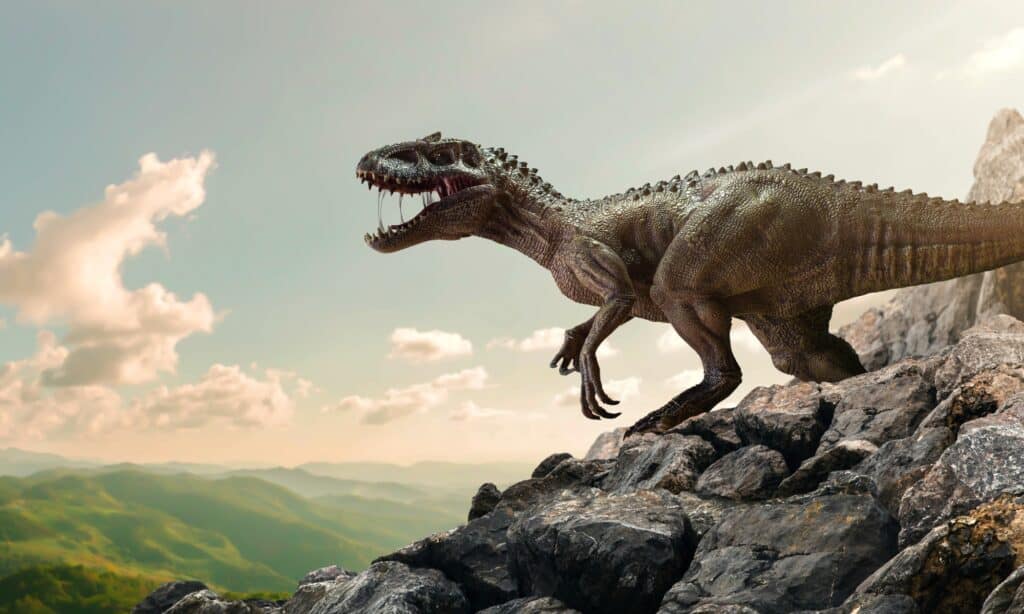
©iStock.com/chaiyapruek2520
2. Velociraptor
Velociraptors also lived during the Late Cretaceous, but from 75 to 71 million years ago. Compared to the man-sized CGI velociraptors you’ve seen in the movies, the real thing was much smaller: only about 18 inches tall at the hip, 6 feet long from the head to the tip of the tail, and weighing no more than 100 pounds. They were still ferocious though. One thing the movies got right was that they had one overgrown claw on each foot for hunting. they may have been able to run as fast as 40 mph, using their long tail to help keep their balance. They lived in forests and hunted small dinosaurs, using their nearly 1-inch-long serrated teeth to bite and tear at the flesh of their victims. Fossils of these meat-eating dinosaurs have been uncovered in Mongolia, China, and Russia.
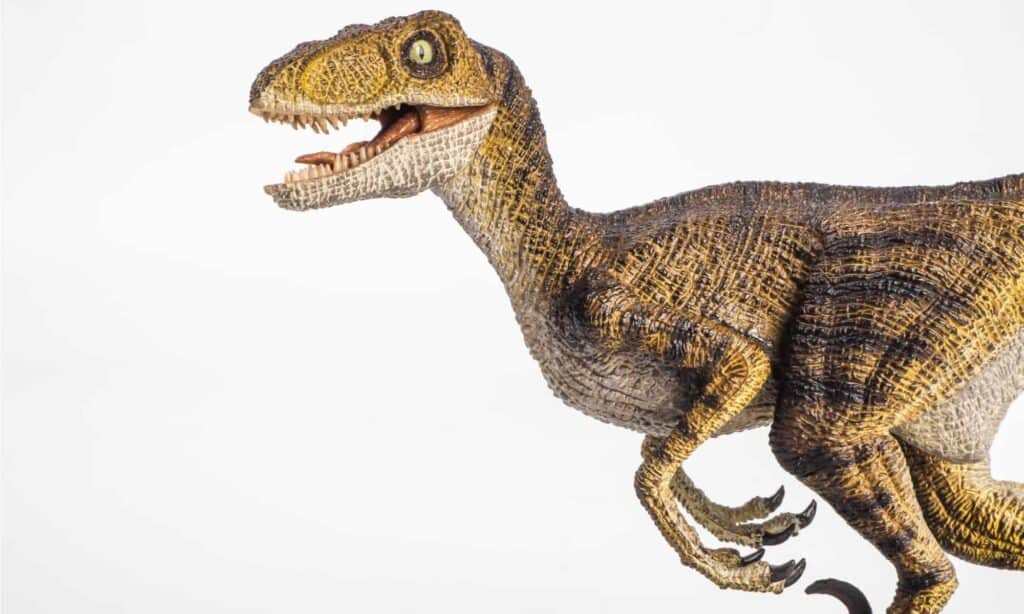
©kamomeen/Shutterstock.com
3. Allosaurus
The allosaurus lived in the Late Jurassic, about 155 to 145 million years ago. At full size, it could grow up to 23 feet long and weigh up to 5 tons. It stalked around forested land hunting herbivorous dinosaurs like stegosaurs or sauropods. When it spotted a likely victim, it could run up to 28 mph to chase it down and use razor-sharp claws and serrated, 4-inch-long teeth to make it into lunch. These guys had horns above their eyes that may have been for several different functions: fighting with enemies, shading the eyes, and attracting the ladies (as a nice pair of shades can sometimes do). Fossils of the allosaurus have been found widely dispersed around the globe, in North America, Europe, Africa, and Australia, so they must have been a successful species.

©Herschel Hoffmeyer/Shutterstock.com
4. Spinosaurus
Spinosaurus is the largest meat-eating dinosaur that has ever been discovered. Weighing in at up to 20 tons and stretching almost 50 feet long, these guys were as long as a semi-truck or the entire length of a water hose in your backyard! And they’d like that water hose, too, because they loved the water. They had webbed feet and a big sail on their back. They may have been a lot like crocodiles: equally comfortable on land and in water. They likely ate fish and small to medium-sized dinosaurs with their 8-inch-long teeth. They lived and died out in the Cretaceous Period, about 112 to 93.5 million years ago, and left their fossils in North Africa, from Egypt to Morocco.
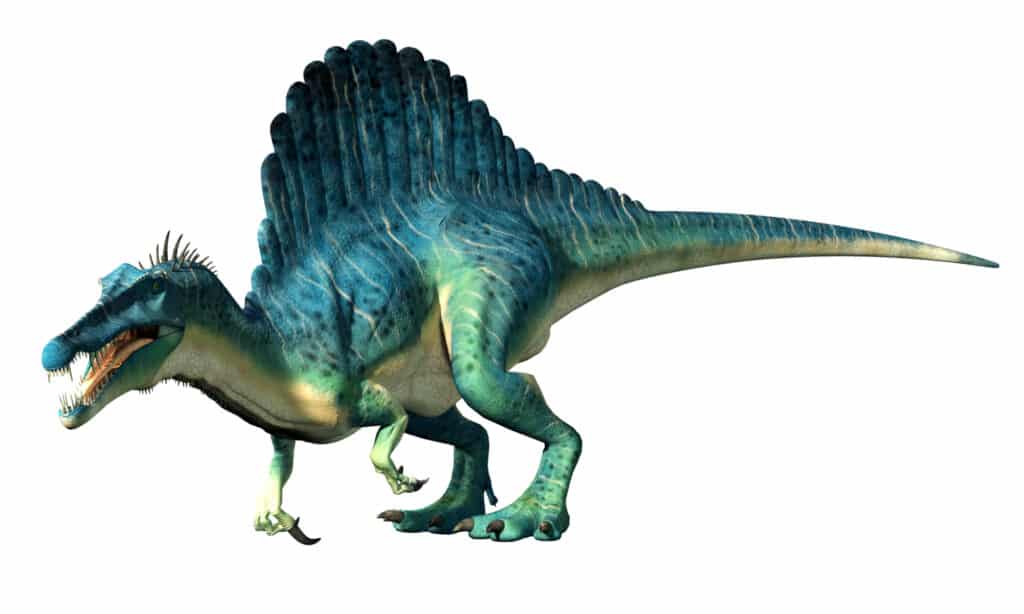
©Daniel Eskridge/Shutterstock.com
5. Carnotaurus
The Carnotaurus lived in the Late Cretaceous period (72-69 million years ago). they went extinct along with the other dinosaurs at the great K-T extinction event that was caused by a meteor impact in what is today Mexico. Carnotaurus lived in areas of plains and forests, mainly in what is today Argentina. The carnotaurus was a carnivore that grew up to 23 feet long and weighed one or two tons. That’s a little lighter than a small car. They had horns above their eyes which gave them an especially wicked and forbidding appearance. Like other therapods, they had oversized muscly back legs and nearly useless little front arms, with a thick tail to help them keep their balance. It’s estimated they could run about 30 miles per hour. That’s about as fast as a coyote or medium-sized dog could run, but faster than the fastest human in the world, Usain Bolt, who set the record at 27.5 mph.

©Daniel Eskridge/Shutterstock.com
6. Giganotosaurus
Gigantosaurus was about the same size and shape as t-rex but lived in a different part of the world. T-rex lived in what is today the Western United States while gigantosaurus lived in Argentina. The time period for gigantosaurus was approximately 99.6 to 97 million years ago, placing it in the Late Cretaceous period. Gigantosaurus grew up to about 43 feet, which is three feet longer than t-rex but was similar in weight, at 6-13 tons. This would be the equivalent weight of one or two African elephants. These guys had large, serrated teeth for sawing through meat and bone. Each tooth was about 8 inches long! They lived in forested areas and would have hunted large herbivorous dinosaurs. They could run maybe as fast as 37 miles per hour as they chased them down.
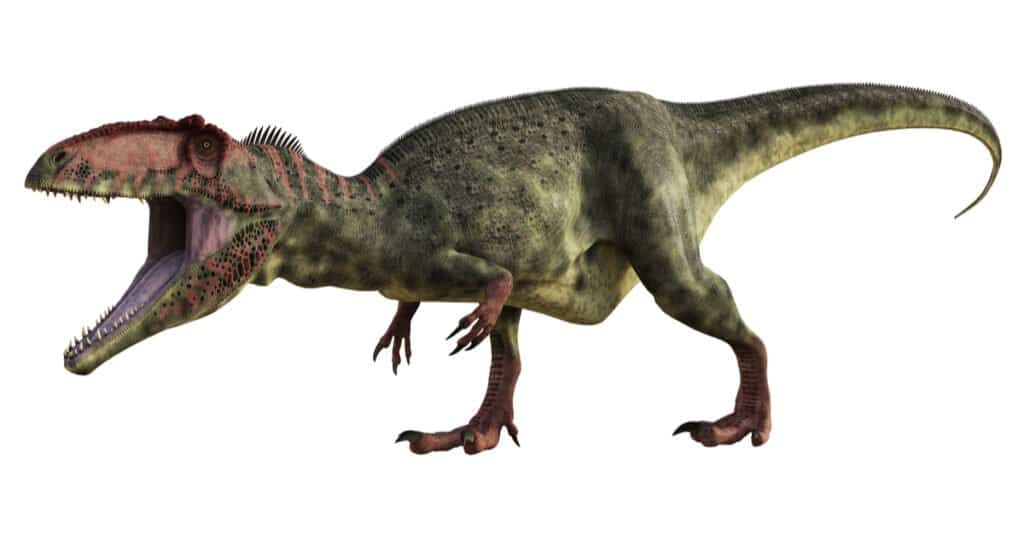
©Herschel Hoffmeyer/Shutterstock.com
7. Deinonychus
Deinonychus lived in the Early Cretaceous period (115-108 million years ago) and went extinct during the K-T extinction event. Their favorite habitats were forests and plains in what is today Montana, Wyoming, and Utah, though fossils have also been discovered in China. They could grow up to 11 feet long and weighed 150-200 pounds, about the weight of an average adult human. Their teeth were about 2 inches long and were serrated. They had long curved claws on their feet. Most interesting, researchers have found evidence these dinosaurs had feathers! This supports the idea that dinosaurs are direct ancestors to the birds we have today. They ran about 30 miles per hour in pursuit of small to medium-sized animals, including other dinosaurs and mammals.

©Elenarts/Shutterstock.com
8. Baryonyx
Baryonyx is a dinosaur that lived in the Early Cretaceous period (130-125 million years ago) and went extinct during the K-T extinction event. The fossils of this creature have been found mainly in England and Spain. A baryonyx could get to be about 25-33 feet long. One of the unusual features of this dinosaur is that the first finger on each of its two hands had a supersized claw on it, about 12 inches long. It had a long, narrow snout sort of like a crocodile and a flexible, s-shaped neck. Like crocodiles and alligators, it may have lived a semi-aquatic lifestyle. We know some things about it ate from fossil evidence that showed fish scales and the bones of a young iguanodontid in its stomach. Researchers think it ate mainly fish but would have eaten smaller dinosaurs or scavenged already-dead carcasses as the opportunity presented itself.
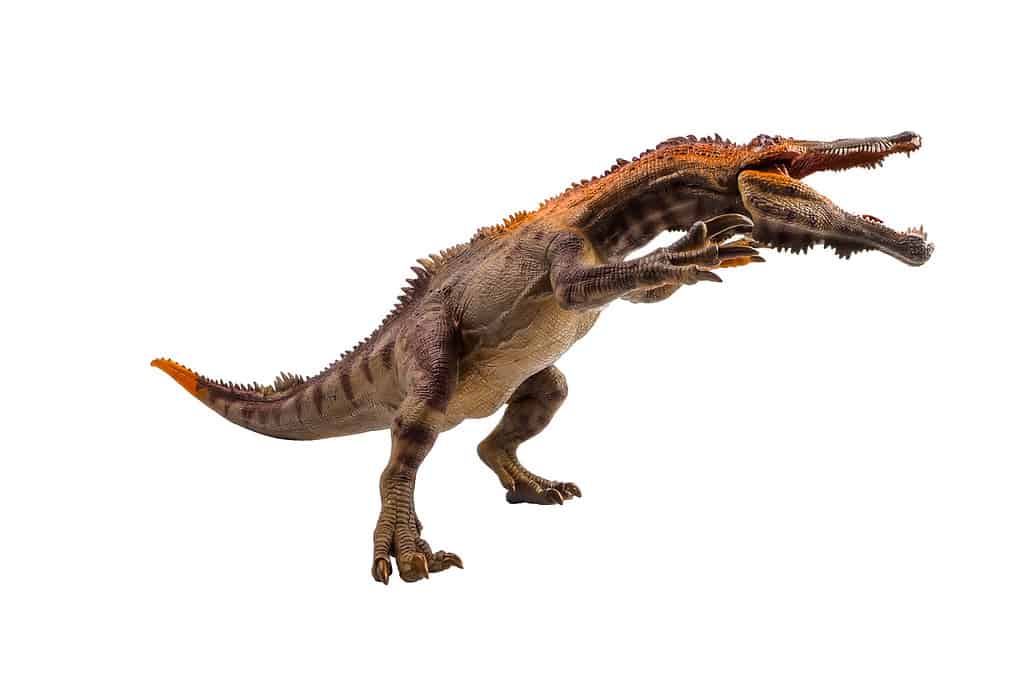
©kamomeen/Shutterstock.com
9. Compsognathus
You might remember the compsognathus from the Jurassic Park II movie. In a horrific scene, a little girl wanders away from a beach picnic with her family and finds a friendly little turkey-sized dinosaur. She offers it some of her food, and suddenly dozens of its friends appear and attack her. Fortunately, the little girl survives the attack, but adults later in the film don’t fare as well. So what are the facts about the compsognathus?
The real creature lived in the Late Jurassic period (155-145 million years ago) in ther forests and plains of what later became Germany and France. They really were just about the size of a skinny turkey and they were carnivores that hunted small animals like insects and lizards. In fact, as least two fossils have been found with the fossilized remains of lizards in their stomachs. Would a whole herd of them have tried to take down something as ginormous as a little girl? Probably not. But that might have a lot to do with how hungry they were and how delicious that sandwhich she had was.
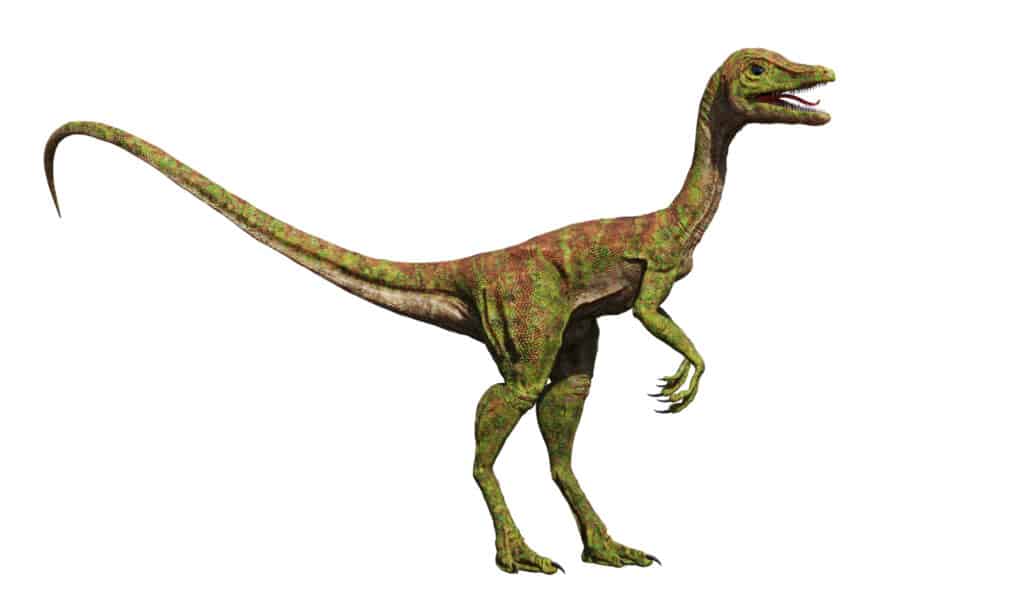
©Dotted Yeti/Shutterstock.com
10. Dilophosaurus
Dilophosaurus became a superstar after the first Jurassic Park movie. Remember when that guy was trying to steal dinosaur embryos in a fake can of shaving cream and got in a jeep accident in the rain? And what he found after he got back in the jeep? AAAAAARGGGHHHH! So in the movie, dilophosaurus had a couple of superpowers we didn’t expect out of a dinosaur: it could flare out a big umbrella-like neck ruffle to scare its prey and the viewing audience, and it could spit acidic blinding venom. Let’s see if there’s any truth to either of those.
Dilophosaurus did indeed live in the Early Jurassic period, approximately 193-183 million years ago. It was about 5 feet tall at the hips, up to 20 feet long overall, and weighed 880-1,100 pounds. This means it was massive – about half the size of a full-grown t-rex, not the small, inquisitive dinosaur depicted in the movie. It did have two crests on its skull, which were shown accurately in the movie. These may have been to help dissipate body heat. Some fossils also show evidence of feathers. And they were fast runners, reaching speeds up to 40 mph. They lived in the prehistoric forests, floodplains, and lakeshores of the Western United States and China where they would have eaten moderately large mammals, reptiles, and other dinosaurs. What about the scary rattling neck ruffle and the acid spit? There’s no evidence for either one. That’s all just Hollywood.
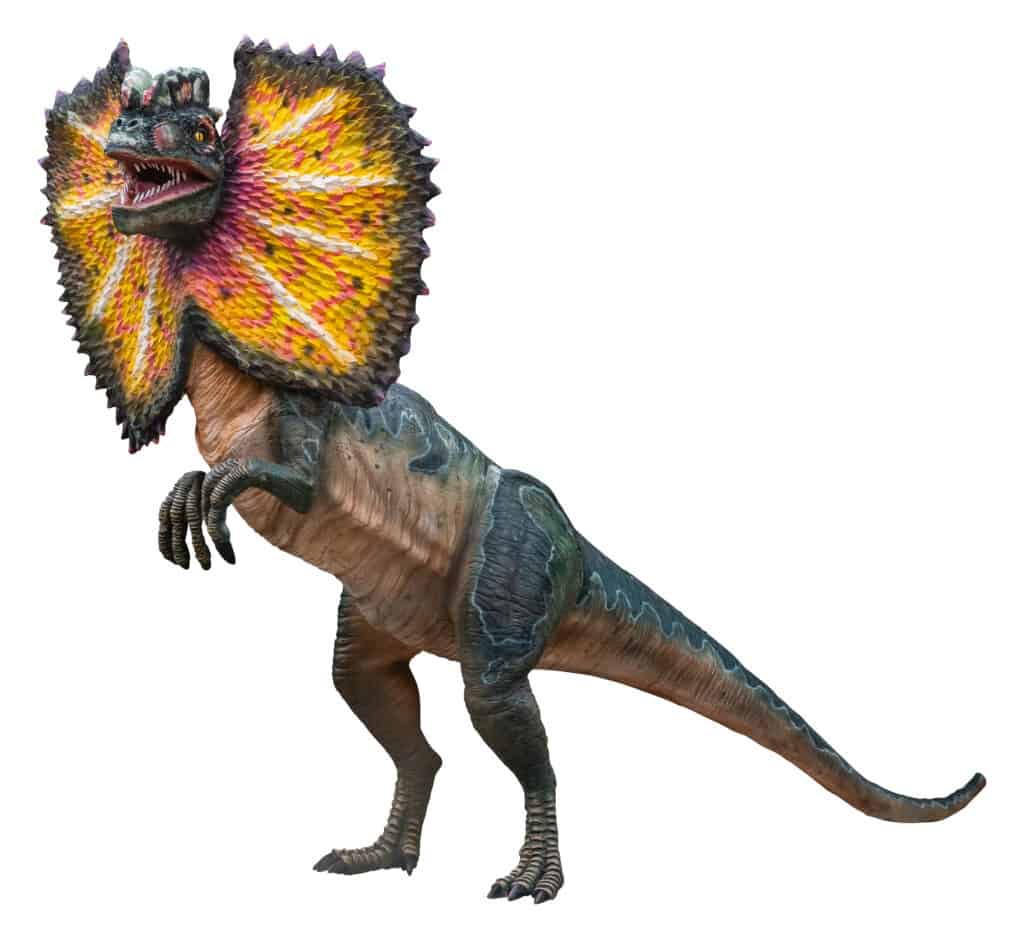
©YuRi Photolife/Shutterstock.com
11. Ceratosaurus
Last on our list is the ceratosaurus, which lived in the Late Jurassic period, around 150-145 million years ago. They grew to 13 feet tall and 20 feet long and could weigh up to 1 ton. That’s about the size of a baby humpback whale, if that helps you. Their teeth were long, curved, and serrated for slicing through flesh. Ceratosaurus had a distinctive horn on its nose and bony projections on its head that may have been used for display or combat. It’s estimated they could reach speedsw of 25 mph. They lived in swampy, forested environments near lakes and rivers. Ceratosaurus was a carnivorous predator that likely fed on other dinosaurs, small mammals, and reptiles. Their fossils have been found in North America (Colorado, Utah, and Wyoming), Europe (Portugal and England), and Africa (Tanzania).
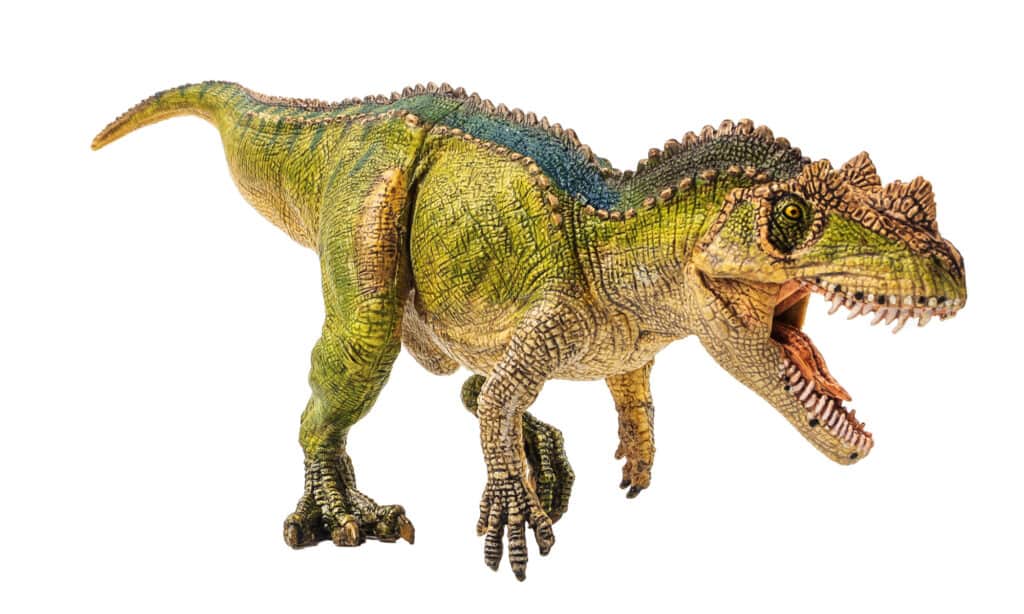
©iStock.com/Kitti Kahotong
And That’s The End . . . or Is It?
So there you have it, 11 of the most horrifying, bloodthirsty, ground stomping, bone chomping, cold-eyed killers the dinosaur world has ever produced. Which is your favorite? Oh wait. You didn’t find your favorite? You say your favorite was a flying pterodactylus or a ginormous undersea mosasaurus? Sad news. They aren’t dinosaurs. You see, the term “dinosaur” has a really specific scientific meaning that, among other things describes a kind of prehistoric creature with legs positioned under their bodies, while those flying and swimming things have limbs sticking out the sides of their bodies. So they’re not really dinosaurs, but just other kinds of prehistoric reptiles. Never fear, we’ll do another article on the baddest swimming prehistoric reptiles ever. Until then . . . pleasant dreams and remember not to share any sandwiches with little dinosaurs.
The post Discover 11 Meat-Eating Dinosaurs appeared first on AZ Animals.
from Animal News, Facts, Rankings, and More! - AZ Animals https://ift.tt/8AgEdyT